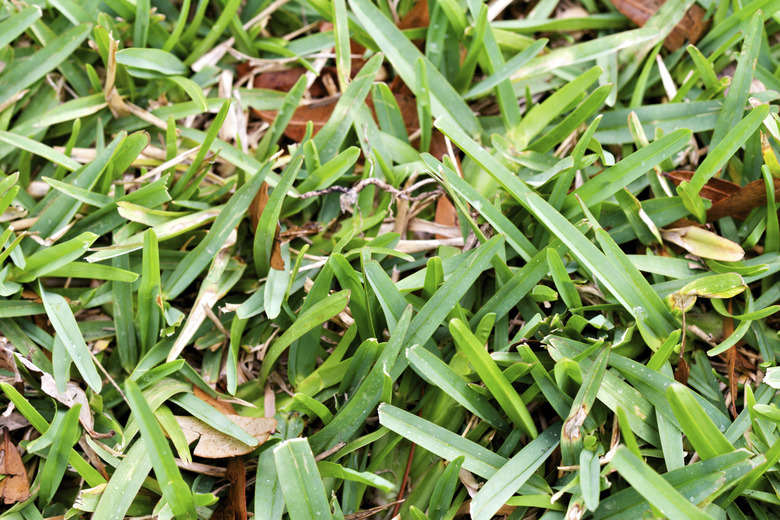Why Is My St. Augustine Grass Yellow?
With its broad, lush blades and tolerance of shade and salt, St. Augustinegrass (Stenotaphrum secundatum) is a versatile warm-weather grass suitable for U.S. Department of Agriculture plant hardiness zones 8 through 10. Unfortunately, it is susceptible to several problems that can cause its leaf blades to turn yellow. Properly diagnosing the cause of the discoloration is crucial to treating it.
Nutrient Needs
A lack of nitrogen in soil can lead to yellowing, particularly in summer. The University of Florida IFAS Extension does not recommend fertilizing with nitrogen in the summer, however, and instead recommends applying 2 ounces of iron sulfate per 3 to 5 gallons of water for every 1,000 square feet of lawn to return the grass' color. Repeat the application every two to four weeks throughout summer. For basic turf maintenance, fertilize with 16-4-8, which is a high-nitrogen blend, in early spring and early fall. For each application, use 1/2 pound of the fertilizer if it is water-soluble or 1 pound if it is a slow-release fertilizer for every 1,000 square feet of lawn.
Ruinous Root Rot
Take-all root rot is a serious fungal disease that initially resembles nutrient deficiency in grass, causing yellow rings in spring and summer. As the disease progresses, the turf begins to die and become thin. Heavy spring and summer rains, as well as excessive nitrogen fertilization, may contribute to the disease. It may help to use fertilizer with ammonium nitrogen rather than nitrate nitrogen. The disease may be controlled with fungicide, ideally as a preventative measure one month before symptoms usually appear. Using a fungicide containing azoxystrobin, mix 1/2 ounce of fungicide in 4 to 5 gallons of water per 1,000 square feet of lawn surface. Apply the fungicide mixture on a windless day twice in the spring, 28 days apart, and twice in the fall, 28 days apart, covering the lawn evenly using an irrigation system, such as a traveler, center pivot, lateral move or hand moveable system. Wear a long-sleeved shirt, long pants, socks, closed-toe shoes and rubber gloves when preparing and using the fungicide mixture. Wash with soap and water, and contact your physician if the fungicide touches your skin.
Chinch Chaos
Patches of dead grass encircled by a halo of yellow grass may be a symptom of chinch bugs, a common pest of St. Augustinegrass. Large amounts of thatch, which is a tangled layer of dead and organic grass matter, makes turf more susceptible than normal to chinch bugs. If your lawn has more than a 1-inch-thick layer of thatch, then consider renting and using a core aerator, which punches holes into the turf, or a vertical mower, which slices into the turf vertically. Also consider planting a chinch bug-resistant St. Augustinegrass cultivar, such as "Captiva," which is hardy in USDA zones 8b through 11.
Chemical Concerns
Whether dry or liquid, chemicals can damage a lawn when spilled by accident, causing yellow or brown spots. Lessen the chance of spillage by using a funnel when dealing with chemicals, such as gasoline for a lawn mower, near your lawn. If you spill something on the lawn, flood the area with water, and then cover the turf with a disposable absorbent product; dispose of the soaked up liquid. Excessive herbicide or insecticide use also can scorch turf.
References
- Clemson Cooperative Extension: St. Augustinegrass
- University of Florida IFAS Extension: Southern Chinch Bug Management on St. Augustinegrass
- Lowe's: Troubleshoot Lawn Damage and Diseases
- Yardcare.com: Warm-Season Grasses
- Texas A&M System AgriLife Extension: Chinch Bugs in St. Augustine Lawns
- Texas A&M AgriLife Extension: Take-All Root Rot
- University of Florida IFAS Extension: Take-All Root Rot
